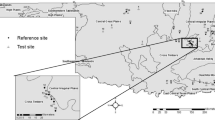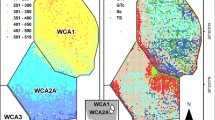Abstract
This study investigated the response of freshwater wetland vegetation to hydrological driving factors by assessing collective vegetation variables, traits of dominant plant populations and hydrological and hydrochemical variables, repeat-sampled within wetland sites across Scotland and northern England. Sampling was conducted at 55 permanent sample stations located along 11 independent transects. Eco-hydrological interactions were investigated using a regression-based modelling approach. Facets of the water-table dynamic (e.g., level of drawdown, level of fluctuation), along with vegetation abundance (e.g., biomass, stem density) and diversity (e.g., species richness) values, were used to build predictive models. Of the models predicting vegetation characteristics, the greatest predictive power was R 2 = 0.67 (p < 0.001) for a model predicting stem density (m−2). Conversely, vegetation variables proved useful for predicting characteristics of the water-table environment. In this instance, the greatest predictive power was R 2 = 0.79 (p < 0.001) for a model predicting minimum water table level (i.e. maximum level of drawdown). The models were tested using data collected during 2000 from repeat sites and independent sites. This approach might be successfully applied for the purposes of integrated eco-hydrological management and monitoring of freshwater wetland vegetation.
Similar content being viewed by others
References
V. J. Abernethy N. J. Willby (1999) ArticleTitleChanges along a disturbance gradient in the density and composition of propagule banks in floodplain aquatic habitats Plant Ecology 140 177–190 Occurrence Handle10.1023/A:1009779411686
M. M. Ali K. J. Murphy V. J. Abernethy (1999) ArticleTitleMacrophyte functional variables versus species assemblages as predictors of trophic status in flowing waters Hydrobiologia 415 131–138 Occurrence Handle10.1023/A:1003833419359
O. M. Bragg P. D. Hulme H. A. P. Ingram J. P. Johnston A. I. A. Wilson (1994) ArticleTitleA maximum–minimum recorder for shallow water tables, developed for ecohydrological studies on mires Journal of Applied Ecology 31 589–592 Occurrence Handle10.2307/2404452
R. J. Daoust D. L. Childers (1998) ArticleTitleQuantifying aboveground biomass and estimating net aboveground primary production for wetland macrophytes using a non-destructive phenometric technique Aquatic Botany 62 115–133 Occurrence Handle10.1016/S0304-3770(98)00078-3
P. Denny (1985) Wetland vegetation and associated plant life-forms P. Denny (Eds) The Ecology and Management of African Wetland Vegetation Junk Dordrecht 1–18
S. Diaz M. Cabido F. Casanoves (1998) ArticleTitlePlant functional traits and environmental filters at a regional scale Journal of Vegetation Science 9 113–122 Occurrence Handle10.2307/3237229
J. C. Duckworth M. Kent P. M. Ramsay (2000) ArticleTitlePlant functional types: an alternative to taxanomic plant community description in biogeography? Progress in Physical Geography 24 515–542 Occurrence Handle10.1191/030913300701542778
I. C. Grieve D. G. Gilvear R. G. Bryant (1995) ArticleTitleHydrochemical and water source variations across a floodplain mire, Insh Marshes, Scotland Hydrological Processes 9 99–110
J. P. Grime J. G. Hodgson R. Hunt (1988) Comparative Plant Ecology: A Functional Approach to Common British Species Unwin Hyman London 742
J. M. Hills K. J. Murphy I. D. Pulford T. H. Flowers (1994) ArticleTitleA method for classifying European riverine wetland ecosystems using functional vegetation groupings Functional Ecology 8 242–252 Occurrence Handle10.2307/2389908
Junk, W. J., P. B. Bayley & R. E. Sparks, 1989. The flood pulse concept in river-floodplain systems. In Dodge, D. P. (ed.), Proceedings of the International Large River Symposium, Canadian special publication of fisheries and aquatic science 106: 110–127
P. A. Keddy (1992a) ArticleTitleAssembly and response rules: two goals for predictive community ecology Journal of Vegetation Science 3 157–164 Occurrence Handle10.2307/3235676
P. A. Keddy (1992b) ArticleTitleA pragmatic approach to functional ecology Functional Ecology 6 621–626 Occurrence Handle10.2307/2389954
P. A. Keddy B. Shipley (1989) ArticleTitleCompetitive hierarchies in herbaceous plant communities Oikos 54 234–241
Kennedy, M. P., 2001. Predicting the impact of hydrological change on wetland vegetation. Ph.D. thesis, University of Glasgow, UK
M. P. Kennedy K. J. Murphy (2003) ArticleTitleHydrological and hydrochemical conditions characterising Carex chordorrhiza L. fil. (String Sedge) habitat in a Scottish floodplain wetland Aquatic Botany 77 243–255 Occurrence Handle10.1016/S0304-3770(03)00107-4
J. Murphy J. P. Riley (1962) ArticleTitleA modified single solution method for the determination of phosphate in natural waters Anal. Chem. Acta 27 31–36 Occurrence Handle1:CAS:528:DyaF38XksVyntr8%3D Occurrence Handle10.1016/S0003-2670(00)88444-5
K. J. Murphy E. Castella B. Clément J. M. Hills P. Obrdlik I. D. Pulford E. Schneider M. C. D. Speight (1994) Biotic indicators of riverine wetland ecosystem functioning W. J. Mitsch (Eds) Global Wetlands: Old World and New Elsevier Amsterdam 659–682
K. J. Murphy G. Dickinson K. Dick K. Greaves M. Kennedy S. Livingstone H. McFerran J. Milne J. Oldroyd R. Wingfield (2003) ArticleTitleAquatic plant communities and predictors of diversity in a sub-tropical river floodplain: the upper Rio Paraná, Brazil Aquatic Botany 77 257–276 Occurrence Handle10.1016/S0304-3770(03)00108-6
Murphy, K. J. & M. J. Hootsmans, 2002. Predictive modelling of aquatic community attributes: biomass, biodiversity, biointegrity and biomonitoring. Acta Limnol. Bras. 14(3): 43–60
Newbold, C. & J. O. Mountford, 1997. English Nature Freshwater Series, No. 5. Water Level Requirements of Wetland Plants and Animals. English Nature, Peterborough
A. O. Nicholls (1989) ArticleTitleHow to make biological surveys go further with Generalised Linear Models Biological Conservation 50 51–75 Occurrence Handle10.1016/0006-3207(89)90005-0
W. H. Patrick I. C. Mahapatra (1968) ArticleTitleTransformation and availability to rice of nitrogen and phosphorus in waterlogged soils Advances in Agronomy 20 323–359 Occurrence Handle1:CAS:528:DyaE3cXovFaltA%3D%3D Occurrence Handle10.1016/S0065-2113(08)60860-3
J. S. Rodwell (Eds) (1991) British Plant Communities, Vol. 1: Woodlands and Scrub Cambridge University Press Cambridge 395
A. J. E. Smith (1978) The Moss Flora of Britain and Ireland Cambridge University Press Cambridge 714
C. Stace (1997) New Flora of the British Isles Cambridge University Press Cambridge 1130
E. V. Watson (1994) British Mosses and Liverworts Cambridge University Press Cambridge
B. D. Wheeler K. E. Giller (1982) ArticleTitleSpecies richness of herbaceous fen vegetation in Broadland, Norfolk in relation to the quantity of above-ground plant-material Journal of Ecology 70 179–200 Occurrence Handle10.2307/2259872
B. D. Wheeler M. C. F. Proctor (2000) ArticleTitleEcological gradients, sub-divisions and terminology of north–west European mires Journal of Ecology 88 187–203 Occurrence Handle10.1046/j.1365-2745.2000.00455.x
B. D. Wheeler S. C. Shaw (1991) ArticleTitleAboveground crop mass and species richness of the principal types of herbaceous rich-fen vegetation of lowland England and Wales Journal of Ecology 79 285–301 Occurrence Handle10.2307/2260713
B. D. Wheeler S. C. Shaw (1995) Plants as hydrologists? an assessment of the value of plants as indicators of water conditions in fens J. Hughes L. Heathwaite (Eds) Hydrology and Hydrochemistry of British Wetlands John Wiley and Sons Ltd. Chichester 63–82
N. J. Willby V. J. Abernethy B. O. L. Demars (2000) ArticleTitleAttribute-based classification of European hydrophytes and its relationship to habitat utilisation Freshwater Biology 43 43–74 Occurrence Handle10.1046/j.1365-2427.2000.00523.x
Willby, N. J., K. J. Murphy, D. J. Gilvear, I. C. Grieve & I. D. Pulford, 1997. Hydrochemical–vegetation interactions on a Scottish floodplain mire. In Large, A. R. G. (ed.), Floodplain Rivers: Hydrological Processes and Ecological Significance. British Hydrological Society, 40–52
N. J. Willby K. J. Murphy I. D. Pulford (1998) ArticleTitleA Scottish flood-plain mire: the Insh Marshes, Strathspey Scottish Geographical Management 114 13–17 Occurrence Handle10.1080/00369229818737021
S. D. Wilson P. A. Keddy (1986) ArticleTitleSpecies competitive ability and position along a natural stress/disturbance gradient Ecology 67 1236–1242 Occurrence Handle10.2307/1938679
Author information
Authors and Affiliations
Corresponding author
Rights and permissions
About this article
Cite this article
Kennedy, M.P., Murphy, K.J. & Gilvear, D.J. Predicting interactions between wetland vegetation and the soil-water and surface-water environment using diversity, abundance and attribute values. Hydrobiologia 570, 189–196 (2006). https://doi.org/10.1007/s10750-006-0191-3
Issue Date:
DOI: https://doi.org/10.1007/s10750-006-0191-3




